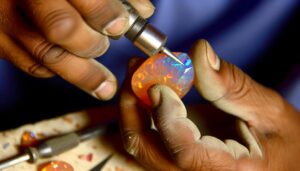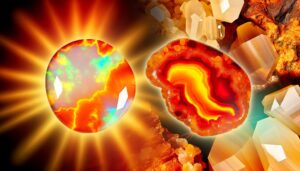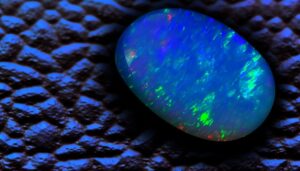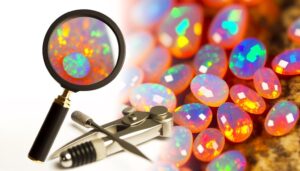Safely Handling Fire Opals to Avoid Burn
You might wonder if fire opal can burn. Due to its hydration levels and amorphous silica composition, fire opal is sensitive to heat.
When exposed to temperatures between 350 to 400 degrees Celsius, the water content within the opal can cause internal stress and potential fracturing. Fundamentally, fire opal does not 'burn' in the way organic materials do, but it can be damaged or even decompose under high thermal stress.
The Si-O bonds within the silica matrix provide some resilience, though hydration variability affects stability. By the way, understanding these thermal thresholds offers more insights into fire opal's behavior under heat.
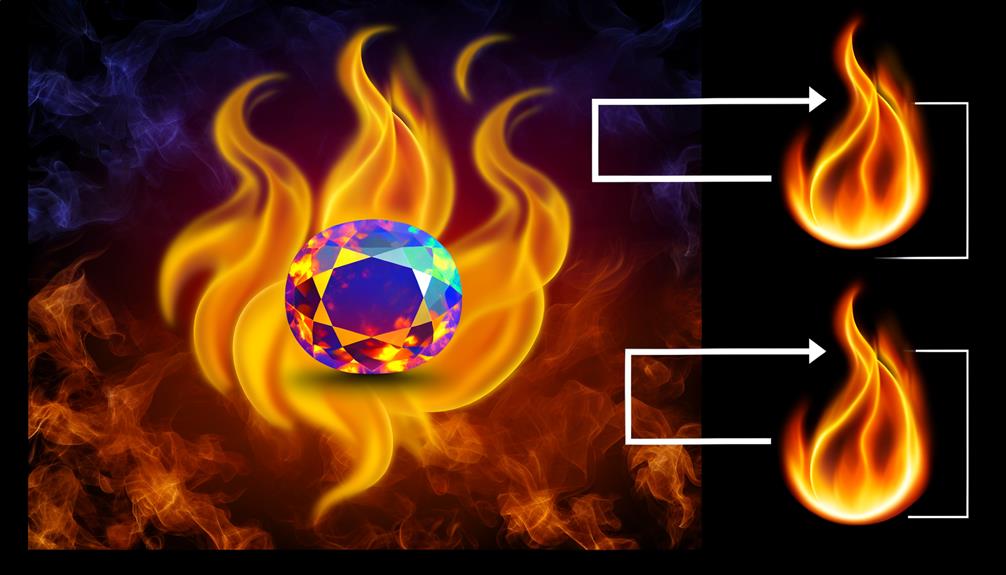
Key Takeaways
- Fire opal's water content can cause internal stress and fracturing under heat.
- Fire opal has a decomposition temperature range between 350 to 400 degrees Celsius.
- High temperatures can lead to dehydration and structural damage in fire opals.
- Fire opal's amorphous silica matrix provides some thermal resilience but not complete immunity to heat.
- Exposure to extreme heat can cause fire opal to crack and lose its vivid colors.
Understanding Fire Opal
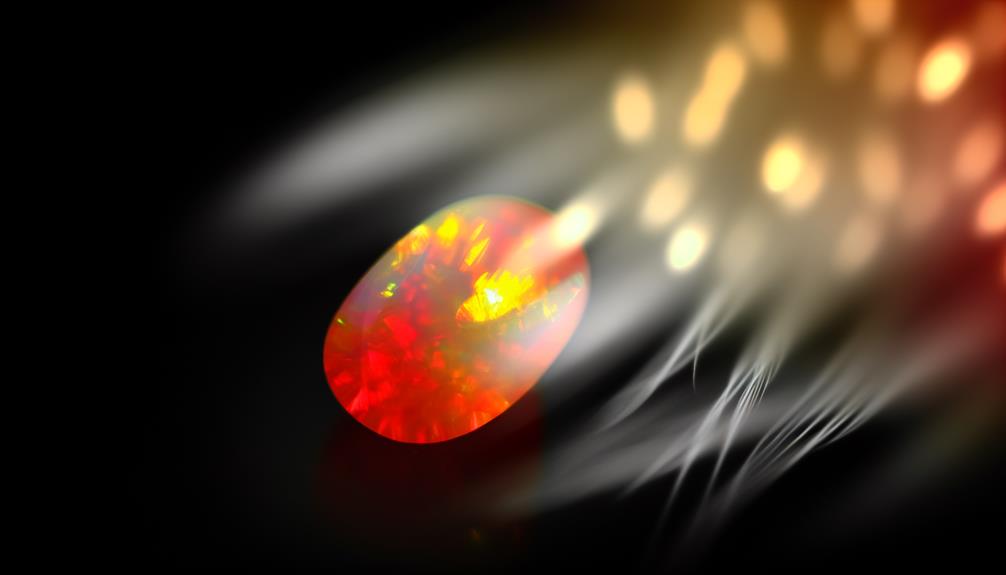
Fire opal, a unique variety of opal known for its vibrant colors and internal play of light, primarily consists of hydrated silica. You'll notice that it displays a spectrum of fiery hues, ranging from yellow to deep red. These colors are due to the diffraction of light within its microscopic silica spheres.
When you observe fire opal, you'll see that it often lacks the 'play-of-color' commonly found in other opals, but its body color itself is striking. This variety forms in volcanic rocks, where low temperatures and high silica content create ideal conditions. By examining its physical properties, such as hardness and refractive index, you can appreciate why fire opal is distinct and valued in gemology.
Chemical Composition
The chemical composition of fire opal primarily consists of hydrated silica (SiO₂·nH₂O), with trace impurities contributing to its vivid coloration. You'll find that these trace elements play a significant role in the gem's unique appearance.
- Hydrated Silica (SiO₂·nH₂O): This is the primary constituent, comprising the bulk of the mineral.
- Iron Oxides: These contribute to the red, orange, and yellow hues.
- Titanium: Often adds to the opal's play-of-color.
- Manganese: Can influence the intensity of the coloration.
These elements collectively define the fire opal's vibrant aesthetic and are essential in understanding its physical and optical properties. This chemical makeup not only determines its beauty but also affects its stability and potential reactions to different environments.
Formation Process
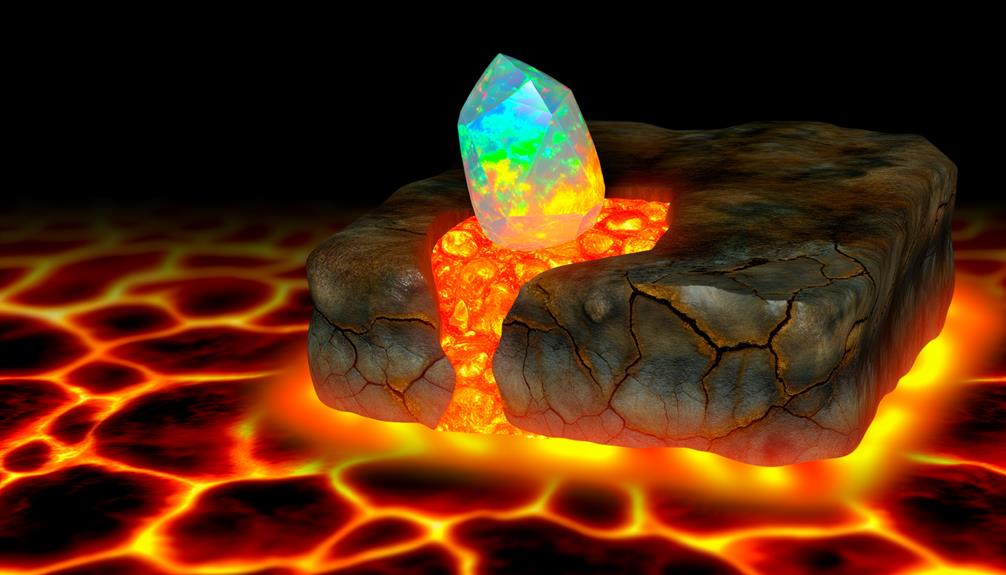
During its formation, fire opal develops in the cavities of volcanic rocks through a process involving the deposition of silica-rich solutions. You'll find that these silica solutions precipitate over time due to the evaporation of water, leaving behind a gel-like substance. This gel undergoes solidification, creating the opal's unique internal structure. The presence of trace elements like iron and manganese can influence the vivid colors you see in fire opal.
Here's a simplified representation:
| Stage | Description |
|---|---|
| Silica-rich solution | Silica dissolves in water within volcanic rock cavities. |
| Precipitation | Water evaporates, leaving behind a silica gel. |
| Solidification | Gel hardens, forming the opal with its characteristic play-of-color. |
Understanding this process helps you appreciate the conditions necessary for fire opal formation.
Heat Resistance
When analyzing fire opal's heat resistance, you'll need to understand its composition, primarily hydrous silicon dioxide.
This mineral's temperature tolerance limits are essential, as exposure to high heat can cause dehydration and structural damage.
Fire Opal Composition
Understanding fire opal's heat resistance requires examining its unique silica-based composition and water content. Fire opal consists mostly of amorphous silica, interspersed with water molecules that can range from 3% to 21% by weight. This structure directly influences its behavior under heat stress.
- Amorphous Silica: Unlike crystalline structures, amorphous silica lacks a definitive lattice, which impacts thermal expansion.
- Water Content: The high water content can lead to internal stress when heated, potentially causing fractures.
- Hydration Level: Variability in hydration levels affects thermal stability and response to heat.
- Chemical Bonds: The Si-O bonds within the silica matrix play a critical role in determining the opal's resilience to thermal changes.
Understanding these factors helps you grasp why fire opals react to heat the way they do.
Temperature Tolerance Limits
How well can fire opals withstand high temperatures before they risk structural damage or fracturing?
Fire opals, composed mainly of hydrated silica, possess a unique internal structure that makes them sensitive to thermal stress. When exposed to temperatures above 100°C (212°F), the water content within the opal begins to evaporate. This dehydration can lead to crazing—tiny fractures that compromise the stone's integrity. Prolonged exposure to heat can exacerbate this effect, causing significant damage.
It's important to remember that fire opals have a lower thermal conductivity compared to other gemstones, making them particularly vulnerable to rapid temperature changes. Maintaining a stable, cool environment is essential for preserving their natural beauty and structural stability.
Melting Point
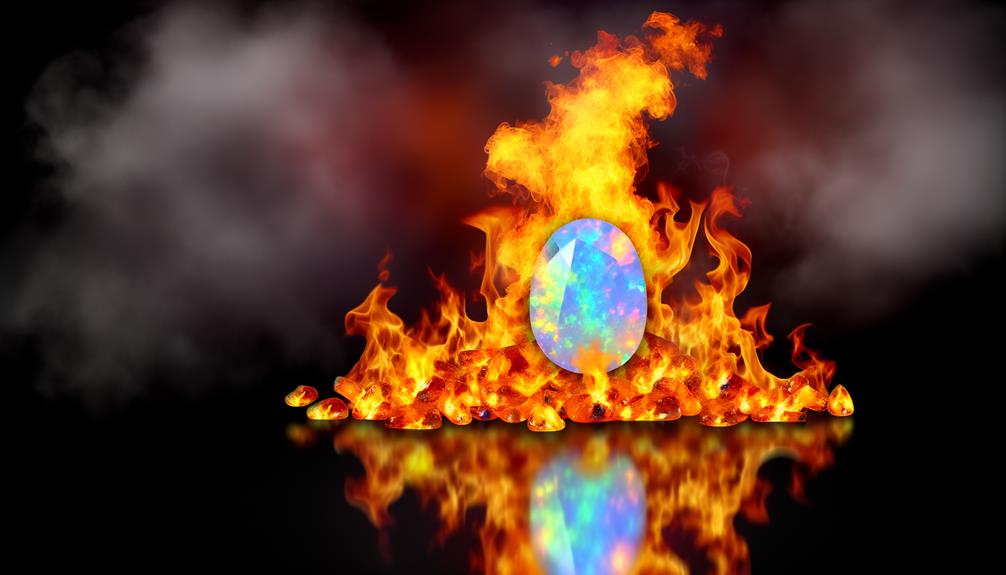
You should understand that fire opal's thermal stability is critical when evaluating its reaction to heat.
Fire opals don't have a true melting point but rather a decomposition temperature range, where they begin to break down structurally.
This range is typically between 350 to 400 degrees Celsius, leading to irreversible changes in the material.
Thermal Stability of Fire Opal
Fire opal's thermal stability can be evaluated by examining its melting point, which is typically around 1600°C (2912°F). This high melting point indicates that fire opal can withstand substantial thermal energy before shifting from a solid to a liquid state.
Understanding this characteristic is essential because it informs how fire opal reacts under various heating conditions.
- Thermal Expansion: Fire opal may expand slightly when heated, impacting structural integrity.
- Surface Cracking: Rapid temperature changes can cause surface fissures due to differential thermal expansion.
- Color Stability: High temperatures may alter the vivid hues characteristic of fire opal.
- Thermal Conductivity: Fire opal has low thermal conductivity, meaning it heats up slowly, reducing the risk of sudden thermal shock.
These factors collectively influence fire opal's practical applications and care.
Decomposition Temperature Range
Considering fire opal's thermal stability, it's important to understand its decomposition temperature range, particularly its melting point, which is a critical factor in determining its behavior under extreme heat.
Fire opal, primarily composed of hydrated silica (SiO₂·nH₂O), lacks a distinct melting point due to its amorphous structure. Instead, it undergoes dehydration and structural breakdown at elevated temperatures, typically around 100°C to 200°C, where water content evaporates.
Beyond this, the silica matrix starts to destabilize, leading to decomposition. At temperatures exceeding 1,000°C, fire opal may undergo significant structural changes, culminating in vitrification or even complete disintegration.
Understanding these thermal thresholds helps you predict fire opal's performance and potential degradation when exposed to high-temperature conditions.
Fire Opal Hardness
The hardness of fire opal, a variety of opal known for its fiery colors, is measured on the Mohs scale, typically ranging between 5.5 and 6.5. This makes it relatively soft compared to other gemstones.
When handling fire opal, you should consider the following:
- Scratch Resistance: Fire opal can be scratched by materials harder than 6.5 on the Mohs scale.
- Durability: It's less durable than harder gemstones like sapphire or diamond.
- Care Instructions: Avoid exposure to harsh chemicals and store separately to prevent scratches.
- Wearability: Suitable for earrings and pendants, but caution is needed for rings due to higher abrasion risk.
Understanding these aspects guarantees you maintain your fire opal's beauty and integrity.
Common Misconceptions
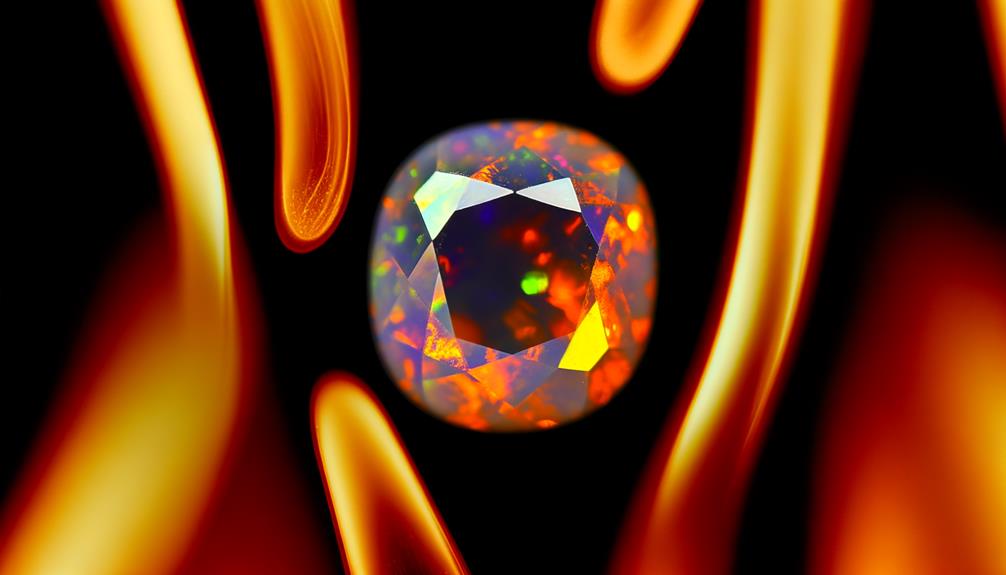
Despite understanding fire opal's hardness and care requirements, many still hold misconceptions about its characteristics and maintenance. One common fallacy is that fire opal can spontaneously combust. Scientifically, fire opal, primarily composed of hydrated silica, cannot ignite. Another misconception is that fire opal is too fragile for everyday wear. In reality, with proper care, its Mohs hardness of 5.5-6.5 makes it reasonably durable. Lastly, some believe fire opal requires constant moisture. While it can benefit from occasional hydration, prolonged exposure to water can cause internal cracking. Here's a quick reference table to clarify:
| Misconception | Reality | Emotional Impact |
|---|---|---|
| Can spontaneously ignite | Scientifically impossible | Relief |
| Too fragile for wear | Durable with care | Reassurance |
| Needs constant moisture | Occasional hydration suffices | Confidence in maintenance |
Mythological Beliefs
Curiously, ancient mythologies often attribute mystical powers to fire opal, believing it to possess the ability to bring good fortune and ward off evil. The stone's vibrant play of colors has fueled various legends and fantastical associations.
You might find it fascinating that fire opal is often linked with:
- Protection: Ancient cultures believed it could shield against negative energies.
- Prophecy: Some thought it could enhance divination abilities.
- Healing: The gem was considered to possess restorative properties for the mind and body.
- Love: Its fiery hues were seen as amplifying passionate emotions.
These beliefs, while not scientifically substantiated, reflect the awe and reverence ancient civilizations held for the mesmerizing fire opal, endowing it with an aura of mystique and power.
Safe Handling Tips
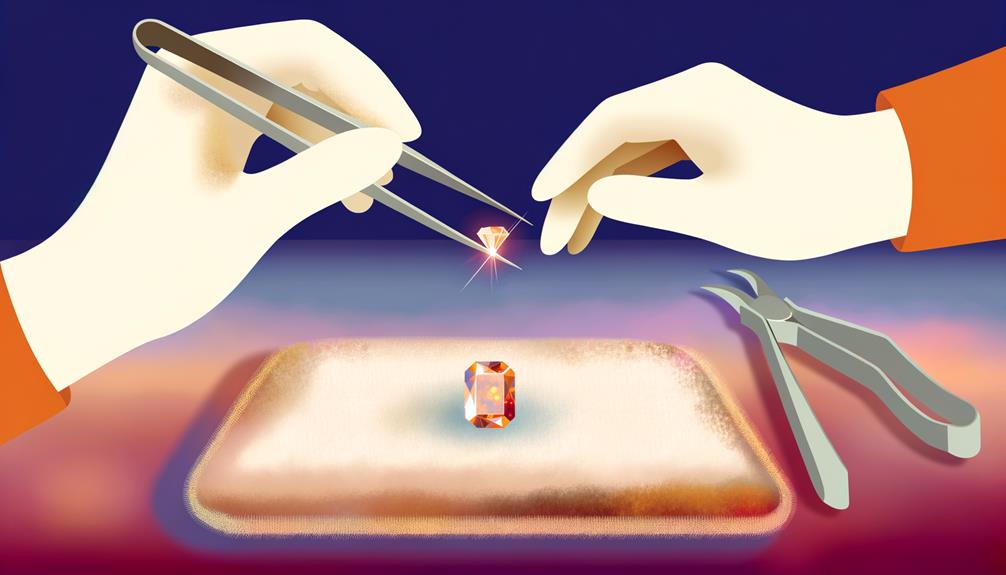
When handling fire opal, you should store it in a cool, stable environment to prevent thermal shock and potential fracturing. Cleaning requires using a soft, damp cloth and avoiding harsh chemicals that can damage the delicate silica structure.
Always guarantee proper hydration by storing the gem with a damp cloth or in a moisture-rich environment to prevent dehydration.
Proper Storage Techniques
Maintaining the longevity and brilliance of your fire opal involves storing it in a cool, dry place away from direct sunlight and extreme temperature fluctuations. Fire opals are hydrophane, meaning they can absorb water, which may lead to cracking or loss of iridescence. Proper storage is crucial to preserve their unique optical properties and structural integrity.
To sustain the quality of your fire opal, consider the following tips:
- Place in a cushioned jewelry box: Minimizes physical damage and exposure to environmental changes.
- Avoid sealed containers: Allows for slight air exchange, preventing moisture buildup.
- Utilize silica gel packets: Controls humidity levels within storage areas.
- Keep out of direct sunlight: Prevents thermal expansion and color fading.
Following these steps guarantees your fire opal remains as stunning as ever.
Cleaning Fire Opal
To clean your fire opal effectively, use lukewarm water and a mild soap solution to avoid damaging its delicate structure. Confirm the soap is non-abrasive to maintain the opal's hydrous silica composition. Gently scrub the surface with a soft brush, avoiding excessive pressure that could cause microfractures.
Avoid ultrasonic cleaners as they can disrupt the stone's internal water content, leading to cracking or crazing. After cleaning, rinse thoroughly with distilled water to remove any soap residues. Pat the opal dry with a soft, lint-free cloth.
Store your fire opal in a moisture-rich environment to prevent dehydration, which can lead to the loss of its characteristic play-of-color. Handle with care to preserve its integrity and beauty.
Comparing to Other Opals
Fire opal, unlike its precious and common opal counterparts, exhibits a vibrant play of colors due to its unique formation and composition. This opal is formed in volcanic regions where silica-rich water fills the voids in lava, creating its distinct warm hues.
Key differences include:
- Color Spectrum: Fire opals display fiery reds, oranges, and yellows, contrasting with the blue, green, and purples of precious opals.
- Transparency: Fire opals are often transparent to translucent, whereas common opals are typically opaque.
- Play-of-Color: While precious opals exhibit a wide-ranging play-of-color, fire opals' play-of-color is often more subtle.
- Formation Environment: Fire opals form in volcanic activity, while precious and common opals typically form in sedimentary environments.
Understanding these differences enhances your appreciation of each opal's unique beauty.
Fire Opal in Jewelry
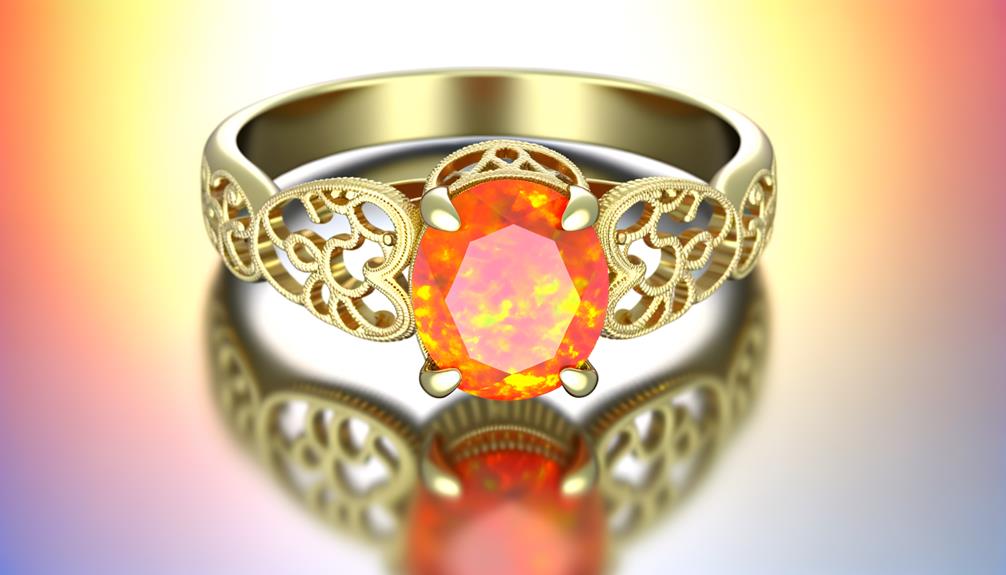
In the world of jewelry, fire opals are highly valued for their vibrant hues and unique transparency, making them a favorite among gem enthusiasts and designers alike. Their dazzling play of colors, ranging from fiery reds to warm oranges, results from the diffraction of light through submicroscopic silica spheres.
When you set fire opals in jewelry, you accentuate their optical characteristics, which can vary based on the stone's cut and clarity. However, fire opals have a Mohs hardness of 5.5 to 6.5, indicating moderate durability. They're best suited for earrings, pendants, and brooches, where mechanical stress is minimal.
Proper handling and setting techniques are essential to maintain the gem's integrity and preserve its captivating appearance.
Enhancing Durability
Given their moderate durability, it's important to explore methods for enhancing the resilience of fire opals in jewelry settings.
One effective approach involves employing protective measures to mitigate potential damage. Consider using the following strategies:
- Doublets and Triplets: Laminate the fire opal between layers of quartz or glass to enhance structural integrity.
- Protective Settings: Choose bezel or halo settings to shield the opal from physical impacts.
- Surface Treatments: Apply resin or polymer coatings to augment the opal's surface hardness and scratch resistance.
- Proper Care: Avoid exposure to harsh chemicals and extreme temperature changes to maintain the opal's stability.
Real-Life Examples
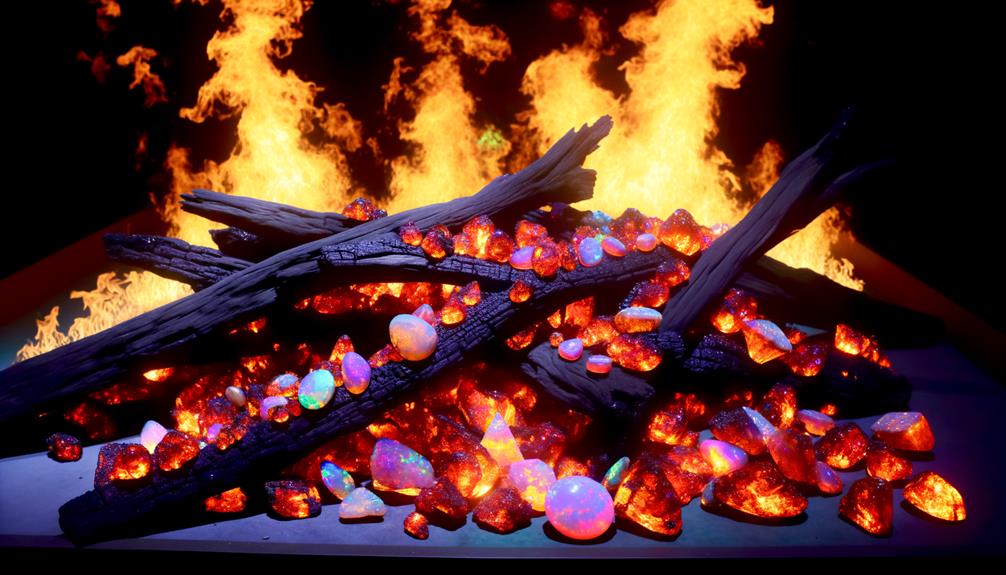
Numerous historical and contemporary instances vividly illustrate the practical applications and challenges faced when incorporating fire opals into intricate jewelry designs.
You'll notice that fire opals, with their unique play-of-color, have been a popular choice for centuries. However, their inherent softness and susceptibility to thermal shock present significant obstacles.
For example, during the Victorian era, jewelers often set fire opals in protective bezel settings to mitigate damage. Modern techniques, such as resin impregnation and doublet or triplet construction, aim to enhance durability.
Despite these advancements, you must still handle fire opal jewelry with care to avoid fractures and crazing. Understanding these real-life examples helps you appreciate the delicate balance between aesthetic allure and material vulnerability.
Conclusion
Essentially, fire opal's vibrant dance of fiery colors masks its surprisingly delicate nature.
You've learned that its chemical composition and formation process make it susceptible to heat damage, unlike its more resilient opal relatives.
When incorporating fire opal in jewelry, it's vital to enhance its durability to withstand everyday wear.
So, while fire opal dazzles with an inner flame, remember—it can indeed burn under intense heat, much like a fleeting ember in a bonfire.

